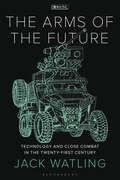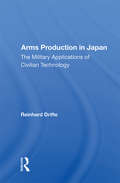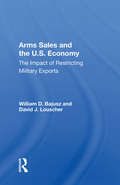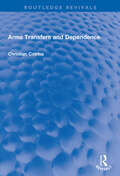- Table View
- List View
The Arms of Kali: Number 59 in Series (The Destroyer)
by Warren Murphy Richard SapirBreathlessly action-packed and boasting a winning combination of thrills, humour and mysticism, the Destroyer is one of the bestselling series of all time.
The Arms of Kali (The Destroyer)
by Warren Murphy Richard SapirBreathlessly action-packed and boasting a winning combination of thrills, humour and mysticism, the Destroyer is one of the bestselling series of all time.
Arms of Nemesis: A Novel Of Ancient Rome (Roma Sub Rosa #2)
by Steven SaylorSouth of Rome on the Gulf of Puteoli stands the splendid villa of Marcus Crassus, Rome's wealthiest citizen. When the estate overseer is murdered, Crasus concludes that the deed was done by two missing slaves, who have probably run off to join the Spartacus Slave Revolt. Unless they are found within five days, Crassus vows to massacre his remaining ninety-nine slaves. To Gordianus the Finder falls the fateful task of resolving this riddle from Hades. In a house filled with secrets, the truth is slow to emerge and Gordianus realizes that the labyrinthine path he has chosen just may lead to his own destruction.
The Arms of the Future: Technology and Close Combat in the Twenty-First Century (New Perspectives on Defence and Security)
by Jack WatlingFrom sensor-fuzed munitions and autonomous weapons, to ground moving target indication radar, laser vibrometers and artificial intelligence, the weapons of warfare are undergoing a rapid transformation, with modern technologies reshaping how armies intend to fight in the twenty-first century. The Arms of the Future analyses how the emergence of novel weapons systems is shaping the risks and opportunities on the battlefield. Drawing on extensive practical observation and experimentation, the book unpacks the operational challenges new weapons pose on the battlefield and how armies might be structured to overcome them. At a time when defence spending across NATO is on the rise, and conflict with Russia raises new questions of what it means to fight a truly 'modern' war, Watling examines not just the arms to be employed but how they can be fielded and wielded to survive and prevail in future wars.
The Arms of the Future: Technology and Close Combat in the Twenty-First Century (New Perspectives on Defence and Security)
by Jack WatlingFrom sensor-fuzed munitions and autonomous weapons, to ground moving target indication radar, laser vibrometers and artificial intelligence, the weapons of warfare are undergoing a rapid transformation, with modern technologies reshaping how armies intend to fight in the twenty-first century. The Arms of the Future analyses how the emergence of novel weapons systems is shaping the risks and opportunities on the battlefield. Drawing on extensive practical observation and experimentation, the book unpacks the operational challenges new weapons pose on the battlefield and how armies might be structured to overcome them. At a time when defence spending across NATO is on the rise, and conflict with Russia raises new questions of what it means to fight a truly 'modern' war, Watling examines not just the arms to be employed but how they can be fielded and wielded to survive and prevail in future wars.
Arms on the Market: Reducing the Risk of Proliferation in the Former Soviet Union
by Gary K. Bertsch Suzette R. GrillotAlmost overnight, the massive military-industrial assets of the Soviet Union came under the jurisdiction of fifteen states instead of one established government. While only four states inherited weapons of mass destruction, most of the fifteen states of the former Soviet Union can produce sensitive materials and equipment. Because all the states se
Arms on the Market: Reducing the Risk of Proliferation in the Former Soviet Union
by Suzette R. Grillot Suzette Grillot RAlmost overnight, the massive military-industrial assets of the Soviet Union came under the jurisdiction of fifteen states instead of one established government. While only four states inherited weapons of mass destruction, most of the fifteen states of the former Soviet Union can produce sensitive materials and equipment. Because all the states se
Arms Production In Japan: The Military Applications Of Civilian Technology
by Reinhard DrifteAlthough Japan's arms industry is still relatively small, significant political, economic, and technological developments indicate its growing importance and pave the way for Japan's increasing involvement in arms production. In this comprehensive study, Dr. Drifte examines both the domestic and international environments that are encouraging Japan
Arms Production In Japan: The Military Applications Of Civilian Technology
by Reinhard DrifteAlthough Japan's arms industry is still relatively small, significant political, economic, and technological developments indicate its growing importance and pave the way for Japan's increasing involvement in arms production. In this comprehensive study, Dr. Drifte examines both the domestic and international environments that are encouraging Japan
The Arms Race at a Time of Decision (pdf): Annals of Pugwash 1983
by Joseph Rotblat Alessandro PascoliniThe Arms Race in an Era of Negotiations
by David Carlton Carlo SchaerfThe countries of NATO and the Warsaw Pact have begun to negotiate for nuclear and conventional arms reductions. The world is no longer bipolar, as the arsenals of China, France and Britain become more significant. This book looks at strategic realities and current global and European problems.
The Arms Race in Asia: Trends, causes and implications (Asian Security Studies)
by Andrew T.H. TanThis book is the first systematic examination of the emerging arms race in Asia. The global trade in arms is to a large degree underpinned by the strong demand for arms in Asia and the Middle East, the two largest arms export markets in the world. Of these two regions Asia has become particularly significant, led by the emergence of China and India as major powers. It is therefore not surprising that the rapid military modernisation in Asia, accompanied by significant increases in the size and sophistication of armed forces, has generated attention as to its trends, key characteristics, causes and implications. This phenomenon, which has become evident since the end of the Cold War, has also been widely described as an Asian 'arms race'. This book evaluates the key conceptual ideas which can shed light on this phenomenon, as well as examining the complex mix of internal, external and technological factors that have led to its emergence. The volume explores the way in which the arms race is leading ultimately to three distinctive blocs in the emerging geostrategic landscape: a loose bloc of US allies in the region; a counter-bloc of potential US adversaries; and a neutral bloc of states with industrial age armed forces whose allegiances will vary according to circumstances and geostrategic developments. The Arms Race in Asia concludes that if the emerging arms race is left unchecked, it is likely that Asia will increasingly become a region of instability, marked by conflicts and interstate wars. The book will be of great interest to students of Asian politics, strategic studies, defence studies, security studies and IR in general.
The Arms Race in Asia: Trends, causes and implications (Asian Security Studies)
by Andrew T.H. TanThis book is the first systematic examination of the emerging arms race in Asia. The global trade in arms is to a large degree underpinned by the strong demand for arms in Asia and the Middle East, the two largest arms export markets in the world. Of these two regions Asia has become particularly significant, led by the emergence of China and India as major powers. It is therefore not surprising that the rapid military modernisation in Asia, accompanied by significant increases in the size and sophistication of armed forces, has generated attention as to its trends, key characteristics, causes and implications. This phenomenon, which has become evident since the end of the Cold War, has also been widely described as an Asian 'arms race'. This book evaluates the key conceptual ideas which can shed light on this phenomenon, as well as examining the complex mix of internal, external and technological factors that have led to its emergence. The volume explores the way in which the arms race is leading ultimately to three distinctive blocs in the emerging geostrategic landscape: a loose bloc of US allies in the region; a counter-bloc of potential US adversaries; and a neutral bloc of states with industrial age armed forces whose allegiances will vary according to circumstances and geostrategic developments. The Arms Race in Asia concludes that if the emerging arms race is left unchecked, it is likely that Asia will increasingly become a region of instability, marked by conflicts and interstate wars. The book will be of great interest to students of Asian politics, strategic studies, defence studies, security studies and IR in general.
Arms Race in the Era of Star Wars: Studies In Disarmament And Conflicts (Studies in Disarmament and Conflicts)
by David Carlton Carlo SchaerfThe Arms Race in the Middle East: Contemporary Security Dynamics (Contributions to International Relations)
by Mohammad Eslami Alena Vysotskaya Guedes VieiraThis edited volume discusses security policy and strategic policymaking in the Middle East region. Due to its unique geopolitical, geoeconomic and geostrategic features, the Middle East region has been confronted with challenging security issues. Combined with a lack of an efficient regional security regime this has led to the formation of a full-fledged arms race. This book draws together contributions from international experts to address the factors that have been contributing to the ongoing formation of an arms race in the Middle East as well as the impact of this phenomenon on the regional and global security environment. The book is organized in three sections. The first section outlines the contemporary dynamics of the arms race in the Middle East by focusing on its most recent dynamics and their implications for regional and international security. The second section conducts systematic analysis of case studies of country-specific drivers of the arms race. The third and final section examines the role of external actors in the arms race, evaluating both the responses of regional actors to external interventions as well as the implications of the arms race for extra-regional countries.
Arms Races in International Politics: From the Nineteenth to the Twenty-First Century
by David Stevenson Joseph Maiolo Thomas MahnkenThis volume provides the first comprehensive history of the arms racing phenomenon in modern international politics, drawing both on theoretical approaches and on the latest historical research. Written by an international team of specialists, it is divided into four sections: before 1914; the inter-war years; the Cold War; and extra-European and post-Cold War arms races. Twelve case studies examine land and naval armaments before the First World War; air, land, and naval competition during the 1920s and 1930s; and nuclear as well as conventional weapons since 1945. Armaments policies are placed within the context of technological development, international politics and diplomacy, and social politics and economics. An extended general introduction and conclusion and introductions to each section provide coherence between the specialized chapters and draw out wider implications for policymakers and for political scientists. Arms Races in International Politics addresses two key questions: what causes arms races, and what is the connection between arms races and the outbreak of wars?
Arms Sales and Regional Stability
by The International Institute for Strategic StudiesThe book considers the main arms exporting countries, including China, Russia, and the US, as well as several European states, and the policies each employs in deciding advanced weapons sales to key regions of the world. It examines whether such sales are inherently stabilising or de-stabilising regarding regional security. Regions reviewed in detail include the Middle East and the Indo-Pacific. Combat aircraft sales are a focus for the volume given both their practical and symbolic importance. The volume focuses on the behaviour and policies of the main arms exporting nations since the end of the Cold War, shifts in their arms export policies, and the tensions that can emerge within or between countries over proposed arms sales. It also considers the impact of countries that were previously only recipients of advanced weapons moving to develop their own defence industrial base.
Arms Sales and Regional Stability
The book considers the main arms exporting countries, including China, Russia, and the US, as well as several European states, and the policies each employs in deciding advanced weapons sales to key regions of the world. It examines whether such sales are inherently stabilising or de-stabilising regarding regional security. Regions reviewed in detail include the Middle East and the Indo-Pacific. Combat aircraft sales are a focus for the volume given both their practical and symbolic importance. The volume focuses on the behaviour and policies of the main arms exporting nations since the end of the Cold War, shifts in their arms export policies, and the tensions that can emerge within or between countries over proposed arms sales. It also considers the impact of countries that were previously only recipients of advanced weapons moving to develop their own defence industrial base.
Arms Sales And The U.S. Economy: The Impact Of Restricting Military Exports
by William D. BajuszThis book addresses the U.S. economic impact of possible restrictions that might be placed on the sale of specific combat equipment to selected countries in the Middle East. It focuses on prospective demand for advanced equipment by Jordan and the member states of the Gulf Cooperation Council.
Arms Sales And The U.S. Economy: The Impact Of Restricting Military Exports
by William D. BajuszThis book addresses the U.S. economic impact of possible restrictions that might be placed on the sale of specific combat equipment to selected countries in the Middle East. It focuses on prospective demand for advanced equipment by Jordan and the member states of the Gulf Cooperation Council.
The Arms Trade and International Law (Studies in International Law)
by Zeray YihdegoShortlisted for the 2008 Young Authors Inner Temple Book PrizeThere are believed to be about 700 million small arms and light weapons (SALW) in the world, often contributing to highly destabilising security and other concerns in international law. SALW are the primary source of violations and abuses of humanitarian and human rights principles by states, rebels, terrorists and criminals. Many consider them the real weapons of mass destruction of our time, causing about half a million deaths annually. The unrestricted international transfer of SALW by states (99 states and 1000 companies involved in manufacturing and supply) is one of the major contributory and aggravating factors of this crisis; another is the illicit traffic in small arms. This book deals with the proliferation of SALW and their unregulated trade and transfer across borders. It addresses questions of definition, manufacturing, trade/transfer, and issues relating to state responsibility. The primary focus is on conventional small arms, in particular military-style weapons. The book tackles the core and most divisive legal problem of whether or not the laws relating to arms control and relevant norms of international law provide substantive restrictions upon the transfer of small arms by states. The application of the norms of international peace and security, non-intervention, humanitarian and human rights laws, and evolved relevant customary rules of arms control relating to these norms are considered particularly carefully. Questions of application and enforcement of relevant rules and institutional responses to the problem are also examined. The UN began considering an arms trade treaty in 2006; the publication of the book at this critical moment in time will make a positive contribution towards shaping the debate and aims to further enhance understanding in an area where close analysis is required.
The Arms Trade Treaty: A Commentary (Oxford Commentaries on International Law)
by Andrew Clapham Stuart Casey-Maslen Gilles Giacca Sarah ParkerThe United Nations Arms Trade Treaty became binding international law in late 2014, and although the text of the treaty is a relatively concise framework for assessing whether to authorize or deny proposed conventional weapons transfers by States Parties, there exists controversy as to the meaning of certain key provisions. Furthermore, the treaty requires a national regulatory body to authorize proposed transfers of conventional weapons covered by the treaty, but does not detail how such a body should be established and how it should effectively function. The Arms Trade Treaty: A Commentary explains in detail each of the treaty provisions, the parameters for prohibitions or the denial of transfers, international cooperation and assistance, and implementation obligations and mechanisms. As states ratify and implement the Treaty over the next few years, the commentary provides invaluable guidance to government officials, commentators, and scholars on the meaning of its contentious provisions. This volume describes in detail which weapons are covered by the treaty and explains the different forms of transfer that the Arms Trade Treaty regulates. It covers international human rights, trade, disarmament, humanitarian law, criminal law, and state-to-state use of force, as well as the application of the treaty to non-state actors.
The Arms Trade Treaty: A Commentary (Oxford Commentaries on International Law)
by Andrew Clapham Stuart Casey-Maslen Sarah Parker Gilles GiaccaThe United Nations Arms Trade Treaty became binding international law in late 2014, and although the text of the treaty is a relatively concise framework for assessing whether to authorize or deny proposed conventional weapons transfers by States Parties, there exists controversy as to the meaning of certain key provisions. Furthermore, the treaty requires a national regulatory body to authorize proposed transfers of conventional weapons covered by the treaty, but does not detail how such a body should be established and how it should effectively function. The Arms Trade Treaty: A Commentary explains in detail each of the treaty provisions, the parameters for prohibitions or the denial of transfers, international cooperation and assistance, and implementation obligations and mechanisms. As states ratify and implement the Treaty over the next few years, the commentary provides invaluable guidance to government officials, commentators, and scholars on the meaning of its contentious provisions. This volume describes in detail which weapons are covered by the treaty and explains the different forms of transfer that the Arms Trade Treaty regulates. It covers international human rights, trade, disarmament, humanitarian law, criminal law, and state-to-state use of force, as well as the application of the treaty to non-state actors.
Arms Transfers and Dependence (Routledge Revivals)
by Christian CatrinaFirst published in 1988, Arms Transfers and Dependence was written to provide a view of arms transfers in the context of the global distribution of power. The book analyses different types of dependence and is focused on comparing the enhancement of military capabilities as a result of arms transfers with the dependence that may be caused by those transfers. In doing so, it provides an overview of how particular structures of imports and exports of arms lead to dependence.
Arms Transfers and Dependence (Routledge Revivals)
by Christian CatrinaFirst published in 1988, Arms Transfers and Dependence was written to provide a view of arms transfers in the context of the global distribution of power. The book analyses different types of dependence and is focused on comparing the enhancement of military capabilities as a result of arms transfers with the dependence that may be caused by those transfers. In doing so, it provides an overview of how particular structures of imports and exports of arms lead to dependence.

















